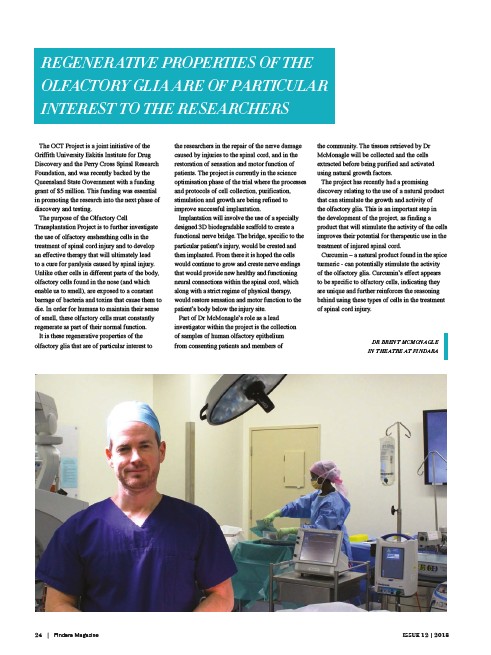
REGENERATIVE PROPERTIES OF THE
OLFACTORY GLIA ARE OF PARTICULAR
INTEREST TO THE RESEARCHERS
The OCT Project is a joint initiative of the
Griffith University Eskitis Institute for Drug
Discovery and the Perry Cross Spinal Research
Foundation, and was recently backed by the
Queensland State Government with a funding
grant of $5 million. This funding was essential
in promoting the research into the next phase of
discovery and testing.
The purpose of the Olfactory Cell
Transplantation Project is to further investigate
the use of olfactory ensheathing cells in the
treatment of spinal cord injury and to develop
an effective therapy that will ultimately lead
to a cure for paralysis caused by spinal injury.
Unlike other cells in different parts of the body,
olfactory cells found in the nose (and which
enable us to smell), are exposed to a constant
barrage of bacteria and toxins that cause them to
die. In order for humans to maintain their sense
of smell, these olfactory cells must constantly
regenerate as part of their normal function.
It is these regenerative properties of the
olfactory glia that are of particular interest to
the researchers in the repair of the nerve damage
caused by injuries to the spinal cord, and in the
restoration of sensation and motor function of
patients. The project is currently in the science
optimisation phase of the trial where the processes
and protocols of cell collection, purification,
stimulation and growth are being refined to
improve successful implantation.
Implantation will involve the use of a specially
designed 3D biodegradable scaffold to create a
functional nerve bridge. The bridge, specific to the
particular patient’s injury, would be created and
then implanted. From there it is hoped the cells
would continue to grow and create nerve endings
that would provide new healthy and functioning
neural connections within the spinal cord, which
along with a strict regime of physical therapy,
would restore sensation and motor function to the
patient’s body below the injury site.
Part of Dr McMonagle’s role as a lead
investigator within the project is the collection
of samples of human olfactory epithelium
from consenting patients and members of
the community. The tissues retrieved by Dr
McMonagle will be collected and the cells
extracted before being purified and activated
using natural growth factors.
The project has recently had a promising
discovery relating to the use of a natural product
that can stimulate the growth and activity of
the olfactory glia. This is an important step in
the development of the project, as finding a
product that will stimulate the activity of the cells
improves their potential for therapeutic use in the
treatment of injured spinal cord.
Curcumin – a natural product found in the spice
turmeric - can potentially stimulate the activity
of the olfactory glia. Curcumin’s effect appears
to be specific to olfactory cells, indicating they
are unique and further reinforces the reasoning
behind using these types of cells in the treatment
of spinal cord injury.
DR BRENT MCMONAGLE
IN THEATRE AT PINDARA
24 | Pindara Magazine ISSUE 12 | 2018